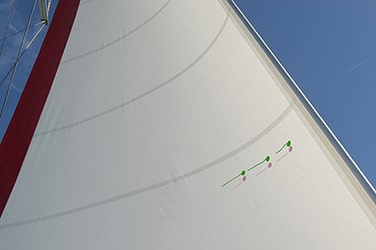Sail Twist Basics
Let’s deal with both of the previous statements.
How can the wind direction be different between the top of the mast and the bottom?
Observe again the car as it speeds up and the apparent wind direction. Set the car speed to the same speed as the true wind of 10 kph. You’ll notice that the apparent wind direction is 30 degrees and the true wind direction has remained constant (of course) at 60 degrees. Wow, that’s a 30-degree difference when the speeds match – double big time wow.
Figure 1.2-1 Animation of a Car Moving in Wind
If the true wind speed increased to 14 kph but the car remained at 10 kph, the true wind would dominate and the difference of the degrees would be less – right? i.e. the apparent wind would tend to be closer to the true. The apparent wind direction would be 24.5 degrees difference to be exact instead of 30 degrees. The slower the vehicle the more the apparent wind acts like the true wind – right?
Now that you’ve got that – conceptualize one more thing. The wind at the surface of the water is slower in speed than the wind 10 meters above the surface because of the friction that the surface imparts to the wind molecules next to it. i.e. the wind minusculely close to the surface is going at zero speed then rises in speed as you get further and further away from the surface. But all things else being equal, these two true wind speeds are in the SAME direction. The phenomenon is called “wind shear”.
Now consider the following interactive animation. We’ve set the true surface wind speed at 10 knots and the top of the mast wind speed at 14 knots as an example.
Watch the apparent wind speeds at the top of the mast vs. the deck level. Not only are they different but the direction is different also. At ten knots of boat speed, the directions are 5.5 degrees different.
Figure 4.1-1 Animation of a Wind at the Top of the Mast vs. at the Surface
That was easy but try to explain this on a napkin and it’s almost impossible.
To account for this then, sail trimmers twist out the top of the sail so that it is flying at its optimum sail set according to the direction of the wind at the top of the mast.





